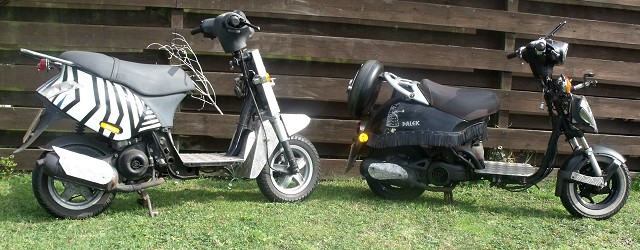Registered on 14th December 2001 as a 50cc Piaggio Zip two-stroke scooter, our featured machine was probably destined to be a ladette’s bike, since it was factory finished in screaming pink! Realistically, few young gentlemen would probably consider a bike in such a colour, which may be why it survived longer than many of its compatriots, and still displayed a low mileage when its last young lady owner acquired the vehicle in June 2013.
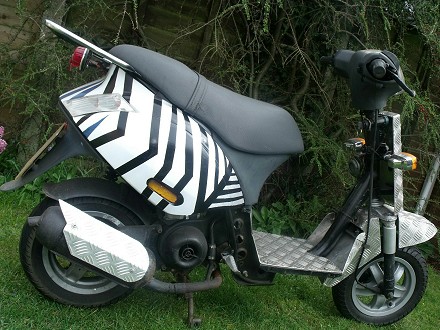
The Zip was ridden by Sophie for a few years, and was maintained by the Mopedland workshops … and pieced back together after it got thrown down the road in Martlesham, straightened out following an off-road excursion through the Brightwell Hill bends, then patched up again following a close encounter of the automobile kind in Ipswich.
Zip was beginning to wear the scars of its recent motoring experiences, but worked fine, and still went well, before shortly becoming largely replaced by a car, after which the scooter received rather less use. Then with a family on the way, Sophie passed the Zip onto her partner, who proceeded to run the scooter through a red light and into a Transit van, and himself into hospital.
The Mopedland workshop van collected the salvaged Zip in December 2016, but this time the plastics were too extensively smashed to be economically repairable. The handlebars were twisted, it was trailing front indicators by their electrical wires, shattered plastics were hanging off, and most of the broken pieces had been tied back to the bike by police tape after its recovery from the crash.
The cost of repairing any 15-year-old scooter wrecked like this meant it was now a complete commercial write-off, and obviously wouldn’t be viable to repair, though the engine still ran, and most things still worked. The workshops inherited the remains, and a plan was imagined to return the bike to operation as an urbanised scooter.
To get some idea of how this might begin, the first thing to do was remove all the broken plastic that would be irrecoverable: the front mudguard, front apron, leg shield back, under tray, and footplate … which didn’t really leave anything much forward of the saddle, just a bare tubular frame!
You then have to imagine how to replace what is necessary to make the bike functional again.
The handlebars were straightened, and the undamaged headlamp nacelle returned to the bar-set. Aluminium chequer-plate was formed to create a new footplate, now with a more practical open access to the electronic ignition pack, HT and spark plug. A short chequer-plate trim was formed and alloy-welded to fit the front of the footplate, mounting off an existing bracket on the frame down-tube (just to cover it up rather than cutting it off), but also to shield the rider’s feet from wind-chill.
The front mudguard was fabricated completely from chequer-plate and welded as two separate pieces, simply bolted to steel mounting brackets welded off the bottom yoke. The front panel was created by folding the sides and top of another piece of chequer-plate, which was cut to a developed cardboard pattern. The joints were alloy-welded, and then the panel drilled to bolt though to fixings on the steering headstock tube.
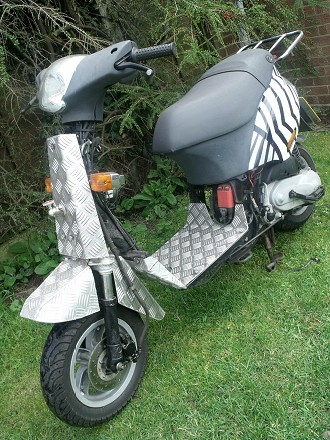
The alloy front panel covers and contains wiring and electrics, and was fitted with a video camera mounting and a 12V power supply socket to the top left just behind the panel so a USB adaptor can allow voltage to be tapped off to power the forward camera.
Leftover Yamaha Salient indicators (at the front), are bolted to a mounting bracket welded behind the headstock tube.
A particular irritation of the Piaggio Zip was a plastic ‘spoiler’ behind the seat, which the rear light was built into. This looked tidy, but proved a poor functional design, since the spoiler was also supposed to serve as a handling point when putting the bike on and off the stand, but always felt uncomfortable to use, and naturally resulted in the rear lens getting broken when handling the bike.
The spoiler and broken rear lamp unit were scrapped as one, and then a steel plate cut to shape to serve as a mounting beneath the seat. A complete rear carrier was then cut to match the outside shape of the steel plate, the tube ends flattened, and welded on to provide a more useful rear carrier and practical handling point. Brackets were welded beneath the carrier tubes to mount an old British rear lamp unit 21W brake light/5W tail, with a second rear lamp mounting another 5W tail lamp, essential to balance up the required front and rear bulb wattage to the constant AC output of the generator coil.
The lower trims were removed from the rear body shell since they obstructed access to the air filter etc, and the rear body shell lower edges were cut back and reshaped to reduce their presence.
While the original dual-seat was retained, the rear footrest positions had been lost with the removal of the original plastic footplate, so a pair of motor cycle folding footrests was bolted into place on the frame to re-enable the passenger option.
The old battery had apparently expired, so a new 12V × 4Ah one was required to get the bike going again, along with a new front tyre.
The final account came to 46 hours work and £60 parts, metal plate, and paint.
Like the last Malaguti Yesterday ‘Dalek’ scooter project, the Zip was also primarily intended as another workshop hack, with the option of mounting a video camera for filming on club runs.
With the mechanics now largely completed, the remaining bright pink paint on the rear body shell was going to have to go … but there’s always that question: what colour now?
There was a temptation to do a ‘military makeover’, and army green might have been an easy option, but wouldn’t seem to go with all the bright silver chequer-plate, and if the alloy was all painted ‘camo’ or black to tone it down, then the bike might appear too drab. A camouflage pattern could seem a less sombre option, but what style? Maybe something that would better match with the silver alloy?
How to camouflage ships at sea was one of the big questions of World War 1. From the early stages of the war, artists, naturalists and inventors showered the offices of the United States Navy and the British Royal Navy with largely impractical suggestions on making ships invisible: Cover them in mirrors, disguise them as giant whales, or drape them in canvas to make them look like clouds… Though protective colouring and covers worked on land, the sea was a markedly different environment. Ships moved through changing light and visibility, they were subject to extreme weather, they belched black smoke and bled rust. Any sort of camouflage would have to work in variable and challenging conditions.
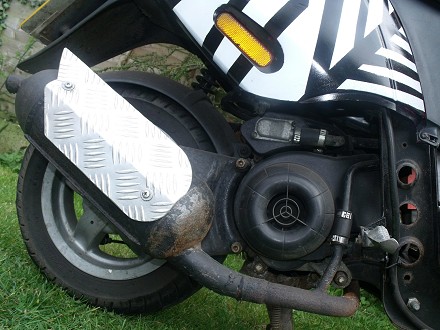
British artist and marine painter Norman Wilkinson’s innovative idea was that rather than using camouflage to hide the vessel, he would use it to hide the vessel’s intention. He concluded that: ‘Since it was impossible to paint a ship so that she could not be seen by a submarine, the extreme opposite was the answer—in other words, to paint her, not for low visibility, but in such a way as to break up her form and thus confuse a submarine officer as to the course on which she was heading.’
In order for a U-boat gunner to fire and hit his target from as far as 1,900 metres away (and not closer than 300 metres, as torpedoes required at least that much running distance to arm), he had to accurately predict where the target would be based on informed guesses. Compounding the difficulty was the fact that he would typically have less than 30 seconds to sight the target ship through the periscope, or risk the periscope’s wake being seen and giving away the submarine’s location. Typical U-boats could only carry twelve very expensive and slow torpedoes at a time, so the gunner had to get it right first time. If you’re a submarine aiming at a ship, you have to calculate how fast a ship is going, where is it going, and aim the torpedo so that they both get to the same spot at the same time. Wilkinson’s idea was to dazzle the gunner so that he would either be unable to take the shot with any confidence, or spoil it if he did. Wilkinson said ‘You only had to be eight to ten degrees off for the torpedo to miss completely. And even if there was a hit, if the torpedo didn’t hit the most vital part that would be better than being hit directly.’
Wilkinson used broad swathes of contrasting colours: black and white, green and mauve, orange and blue, in patterns of geometric shapes and curves to make it difficult to determine the ship’s actual shape, size and direction. Curves painted across the side of the ship could create a false bow wave, for example, making the ship seem smaller or imply that it was heading in a different direction. Patterns disrupting the line of the bow or stern made it hard to tell which was the front or back, where the ship actually ended, or even whether it was one vessel or two; and angled stripes on the smokestacks could make the ship seem as if it was facing in the opposite direction.
To prove the effectiveness of the concept, a demonstration was arranged for someone whose opinion would carry enough weight to progress the theory … and who better than King George V, who had served in the Royal Navy before the death of his older brother put him first in line for the throne, so he well understood about naval matters. The King was shown a tiny model ship, painted, not in standard battleship grey, but in an explosion of dissonant stripes and swoops of contrasting colours. The model was mounted on a turntable set against a seascape backdrop, and George was then asked to estimate the ship’s course, based on his observations from a periscope fixed about 10 feet away. The King very well knew what he was doing, and ‘South by west’, was his firm answer. ‘East–southeast’ came the reply from Norman Wilkinson, and George V was astounded, ‘dazzled’ even. ‘I have been a professional sailor for many years’, the confounded King reportedly said, ‘and I would not have believed I could have been so deceived in my estimate.’
Wilkinson’s innovation of dazzle camouflage, it seems, was a success.
After earning the King’s support for his idea, Wilkinson was given the chance to further test his theory in the water. The first ship to be ‘dazzled’ was a small store ship called HMS Industry; when it was launched in May 1917, coastguards and other ships sailing the British coast were asked to report their observations of the vessel when they encountered it. Enough observers were sufficiently confused, that by the beginning of October 1917, the Admiralty asked Wilkinson to dazzle 50 troopships.
The United States, which joined the war on April 6, 1917, was then grappling with as many as six systems of camouflage, most of which claimed low visibility or invisibility to private ship owners. The US Navy however, had little confidence in the claims of diminished visibility and moreover, was also dealing with the further problem that many of its ships had been German built vessels—meaning that the enemy knew their speed and vulnerabilities. When news of the dazzle system and its ability to mask the speed and kind of ships reached Britain’s new ally, a young Franklin Roosevelt, then assistant to the secretary of the navy, agreed to meet with Wilkinson to discuss it. After another successful demonstration of dazzle, in which a confused US admiral reportedly exploded, ‘How the hell do you expect me to estimate the course of a God-damn thing all painted up like that?’ Wilkinson was subsequently asked to help set up an American dazzle department under the Navy’s Bureau of Construction and Repair.
One American dazzle camoufleur (the actual term for a camouflage artist) referred to the optical distortion concept undergirding Dazzle as ‘reverse perspective’, also known as forced perspective and accelerated perspective; being optical illusions that create a disconnect between what the viewer perceives and what is really happening. In practice, the principle did have its limitations—it could only be applied to ships that would be targeted by periscopes, because it worked best when seen from the low-down viewpoint of a U-boat gunner.
Following the paint job in white, black, & blue strips at the back, and a drift of silver mist at the front to ‘blend’ into the alloy-work, the Zip has subsequently become more commonly known as ‘Dazzle’, with its artwork scheme based on the pattern of HMS Argus, the first British aircraft carrier.

HMS Argus
We feel that the dazzle camouflage does seem to work, as although the Zip has been on the road since July 2017, it has never been torpedoed…
While the cycle appearance has been dramatically changed, other than removal of the variator collar to extend its drive ratio range, the engine remains completely standard, and even the original EGR (exhaust gas regulator) circuit remains.

The ignition switch also functions as a steering lock, one position to release, then second position to switch on. The electric starter is inhibited, it needs either brake lever to be pulled on to effect the electric starter. Alternatively, you can kick-start it on the stand, but when the stand is up, it blocks the kick-starter arc, so this method is only an option when the stand is down.
The petrol tap is vacuum operated, and the choke is automatic, though starting always seems to require a bit of throttle twisting to encourage the engine to catch. Nudge off the stand, and although you can twist-and-go pretty much right away, the motor won’t be working at its best until the choke phase has cleared and the motor warmed up. Since we’re accompanied by Dalek (with its Sat-nav) as our pacer, comparisons between the two machines are going to be inevitable. Dazzle demonstrates capable torque from the off, but doesn’t deliver the same acceleration punch as Dalek, which also maintains its edge throughout the mid range.
Dazzle’s obvious strong points are, however, that it has appreciably better brakes and handling than Dalek, which can bounce alarmingly through bumpy corners, often forcing its jockey to back off in the interest of self-preservation, while Dazzle proves much more confident and manageable through the same bumpy sections.
Both Dazzle’s brakes deliver stronger and more controlled braking, so the nimble Zip makes up its lesser power in other ways, but doesn’t find the speed once the two bikes get onto the straight.
Despite the obviously exaggerated speedometer readings of up to 80km/h (50mph) Dazzle only manages a best pace of 38mph with rider sitting upright, then holding on the throttle in a tight and low tuck behind the handlebar nacelle, can just about be worked to top 40mph, but Dalek easily commands the performance by a comfortable 5mph margin.
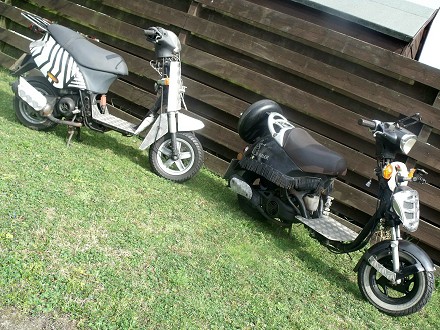
The 2T Zip won’t deliver the same kind of power up to speed as the Minarelli 2-CV in Dalek, but does keep slowly and steadily building up its pace if you hold onto the throttle, tuck down low to reduce the drag, and work at progressively creeping up the revs. It’s rather as if it’s over geared for the output of the motor, so would certainly have some tuning potential to increase its performance if you wanted more go. There seems to be lots of information about de-restricting a 2T Zip, and performance goodies if you’re after more power, but we’re happy to leave Dazzle with the standard motor, because it does everything that we want of it capably enough, so that’s fine as it is.
Dazzle’s 12V × 35/35W headlamp with the luxury of beam & dip is way more effective than Dalek’s poor 12V × 15W single filament, and both scooters’ lighting systems only operate when their engines are running because they power their lights with AC run directly from the generator coils.
The Malaguti 50cc ‘Dalek’ is only a single-seater, and considering that Dazzle is also only 50cc capacity, we wondered about the effectiveness of Dazzle’s two-seater capability, so tried it out on the hilly EACC Bluebell Run with a passenger. Apart from some adjustment required to compensate for the resulting tail-heavy/front-light imbalance, the bike accomplished its task very well, and completed all its trials along the course very competently … a surprisingly capable 50!
We were less impressed with the ‘helmet bin’ beneath the saddle, which wasn’t capable of closing the seat on a basic open-face helmet! It might seem a ridiculous design that requires you to shop for a presumably special helmet that fits the limited bin space.
Mutation of the Zip into another Urbo-scoot only came about due the unfortunate circumstances of the bike’s sequence of accidents rendering it an economic repair write-off. Though relatively cheap to restore by this means, the time required to complete the conversion wouldn’t have been commercially practical for the worth of the final result, but it did give the bike a second lease of useful life where it would have otherwise been nothing but scrap.
It’s relatively easy to find many similar and quite cheap examples of crash-damaged scooters with expensive broken plastic, though few mechanical issues, so there is certainly a plentiful supply of suitable donor machines to base these sorts of reconstructions upon.
All you need is time, and a little imagination…


